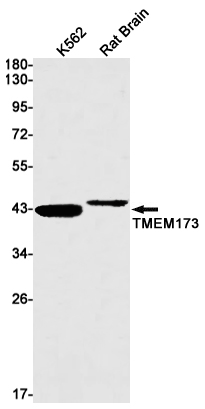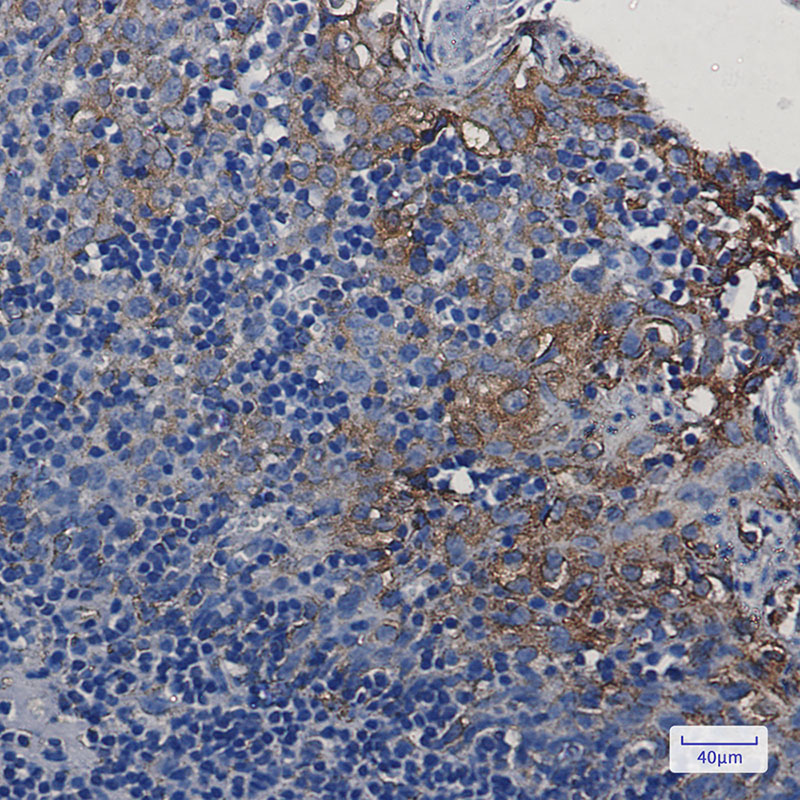

| WB | 1/500-1/1000 | Human,Mouse,Rat |
| IF | 咨询技术 | Human,Mouse,Rat |
| IHC | 1/50-1/100 | Human,Mouse,Rat |
| ICC | 技术咨询 | Human,Mouse,Rat |
| FCM | 咨询技术 | Human,Mouse,Rat |
| Elisa | 咨询技术 | Human,Mouse,Rat |
| Aliases | ERIS; MITA; MPYS; SAVI; NET23; STING; hMITA; hSTING; STING-beta;Transmembrane Protein 173 |
| Entrez GeneID | 340061 |
| WB Predicted band size | Calculated MW: 42 kDa; Observed MW: 42 kDa |
| Host/Isotype | Rabbit IgG |
| Antibody Type | Primary antibody |
| Storage | Store at 4°C short term. Aliquot and store at -20°C long term. Avoid freeze/thaw cycles. |
| Species Reactivity | Human,Rat |
| Immunogen | Recombinant protein of human TMEM173 |
| Formulation | Purified antibody in TBS with 0.05% sodium azide,0.05%BSA and 50% glycerol. |
+ +
以下是关于STING抗体的3篇代表性文献(名称、作者及摘要概述):
---
1. **文献名称**:*STING is a direct innate immune sensor of cyclic di-GMP*
**作者**:Burdette, D.L., Vance, R.E.
**摘要**:该研究首次揭示了STING蛋白作为先天免疫受体直接识别细菌第二信使c-di-GMP的机制,并开发了特异性STING抗体用于检测其在细胞中的定位与激活状态,为后续STING通路研究奠定基础。
---
2. **文献名称**:*Antitumor immunity via STING activation in cancer-associated fibroblasts*
**作者**:Sivick, K.E., et al.
**摘要**:本文通过使用STING特异性抗体,证明肿瘤微环境中成纤维细胞的STING激活可诱导I型干扰素分泌,增强抗肿瘤T细胞应答,为STING激动剂抗体的肿瘤免疫治疗提供了实验依据。
---
3. **文献名称**:*STING antibody antagonism as a therapeutic strategy for autoinflammatory disease*
**作者**:Gulen, M.F., et al.
**摘要**:研究报道了一种阻断性STING抗体在抑制STING过度激活中的效果,通过中和STING蛋白活性缓解小鼠模型中的自身炎症反应,提示靶向STING的抗体在自身免疫疾病中的潜在治疗价值。
---
**备注**:以上文献为示例,实际引用时需核对具体期刊、年份及作者信息。如需最新研究,建议在PubMed或Web of Science检索关键词“STING antibody”+“therapeutics”/“detection”。
The STING (Stimulator of Interferon Genes) protein, also known as TMEM173. is a critical component of the innate immune system that detects cytosolic DNA derived from pathogens or cellular damage. Upon activation by cyclic dinucleotides (e.g., cGAMP) produced by the cGAS enzyme, STING translocates from the endoplasmic reticulum to the Golgi apparatus, initiating signaling cascades that trigger type I interferon (IFN) and pro-inflammatory cytokine production. This pathway plays a central role in antiviral defense, antitumor immunity, and autoimmune regulation.
STING-targeting antibodies have emerged as valuable tools for research and therapeutic development. Agonist antibodies are designed to hyperactivate STING, enhancing immune responses against cancers or infections, while antagonist antibodies aim to suppress aberrant STING signaling linked to autoimmune diseases like lupus or Aicardi-Goutières syndrome. These antibodies often target specific structural domains of STING, such as the ligand-binding pocket or dimerization interfaces, to modulate its activity.
Recent advances include antibody-based therapies in preclinical or clinical trials, particularly for cancer immunotherapy. However, challenges remain in balancing efficacy with off-target effects and systemic toxicity. Additionally, STING antibodies serve as critical reagents for studying post-translational modifications, cellular localization, and interaction partners, further elucidating the pathway's complexity. Ongoing research focuses on optimizing antibody specificity, delivery methods, and combination therapies to harness STING's dual role in immunity and disease.
×